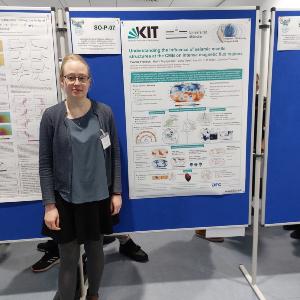Conference start: DeepDyn at the DGG annual conference
27 Mar 2024
Deep down in the earth, at the border between the mantle and the core, special structures lie hidden.
27 Mar 2024
Deep down in the earth, at the border between the mantle and the core, special structures lie hidden.

© Yvonne Fröhlich
Deep down in the earth, at the border between the mantle and the core, special structures lie hidden.
Yvonne Fröhlich, a doctoral student at KIT in Karlsruhe, presented the seismology project within DeepDyn at this year's DGG annual conference in Jena.
Understanding the influence of seismic mantle structures at the core-mantle boundary on intense magnetic flux regions, as the title states, examines the zones of intense magnetic flux in more detail, which usually occur as related pairs at higher geographical latitudes. These so-called high latitude flux lobes are very stable in certain locations, such as the Canadian pair (Canada - Antarctica) and Siberian pair (Silberia - South Indian Ocean) - despite a constantly changing magnetic field around these regions.
It has been assumed for around 60 years that structures deep down in the earth influence the earth's magnetic field. Using images from seismic studies, the research groups of Prof. Joachim Ritter from Karlsruhe and Prof. Christine Thomas from Münster want to investigate and map these structures between the Earth's core and mantle. Recordings of strong earthquakes allow a look into the interior of the earth and thus make it possible to estimate the extent and chemical composition of these regions.
Together, Yvonne Fröhlich, Fiona Dorn and Muhammad Dillah (Karlsruhe) as well as Harini Thiyagarajan and Lena Tölle (Münster) are investigating the question of how well heat and electrical energy can be conducted in the border area between the Earth's mantle and core. This helps the team investigate the influence of mineralogical, direction-dependent crystal structures and different temperatures deep in the Earth on the formation of zones of high magnetic flux on the Earth's surface.
This information then flows into computer simulations of the geodynamo, which other sub-projects of the research network develop.
A scientific summary of Yvonne's poster can be found in the DGG 2024 conference proceedings on pages 181-182.
SO-P-07
Y. Fröhlich1, H. Thiyagarajan2, L. Tölle2, J. R. R. Ritter1, C. Thomas2
1Karlsruhe Institute of Technology, Geophysical Institute, Karlsruhe, 2University of Münster, Institute of Geophysics, Münster
Within the Priority Program 2404 “Reconstructing the Deep Dynamics of Planet Earth over Geologic Time” (DeepDyn) we investigate possible seismic signatures at magnetic highlatitude flux lobes (HLFL). The focus is on four target regions on the northern hemisphere: Siberia, Canada, North Atlantic and Indonesia. While Siberia and Canada show the HLFL, the North Atlantic should be the location of a third postulated flux lobe, but this area shows no high-flux signal in the magnetic field. The region beneath Indonesia and the Indian Ocean is characterized by an area of high magnetic flux that changes direction and moves westwards over time. Our aim is to understand whether mineralogy and seismic structure (i.e., thermal constraints) could be responsible for the different magnetic signatures at the core mantel boundary (CMB). This is done by combining two approaches: seismic anisotropy and seismic reflections near the CMB. To study anisotropy, we measure shear wave splitting of SKS, SKKS, and PKS phases as well as of S and ScS phases. Thereby, we determine the splitting parameters, the fast polarization direction ϕ and the delay time δt as well as the splitting intensity SI. Especially, we search for phase pair discrepancies, e.g., between SKS and SKKS phases, as they are a clear indication for a lowermost mantle contribution to the anisotropy. Based on our shear wave splitting measurements, we will derive structural and mineralogical anisotropy models using the MATLAB Seismic Anisotropy Toolbox (Walker and Wookey 2012). To test these models, we simulate synthetic seismograms using AxiSEM3D (Leng et al. 2016, 2019). Besides comparing synthetic and observed seismograms, we plan to measure the shear wave splitting of the synthetic phases and compare splitting parameters and splitting intensity to the observed values. The second approach uses seismic reflections (P and S waves) from the D” discontinuity, located 300 km above the CMB, and measures their arrival time, slowness, polarity and waveform, using array analysis. We aim to cover the regions with a number of crossing paths, for verification and also for determining whether anisotropy is present (Pisconti et al., 2022). Especially the polarity of the reflected waves, when taken together with the splitting analysis, can help to find the mineralogy that leads to the observed structures near the CMB, which in turn will help to understand the influence of the mantle on core dynamics.